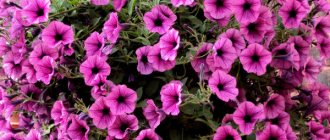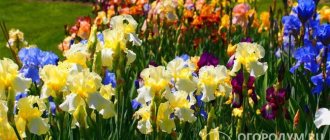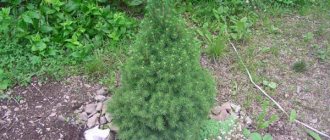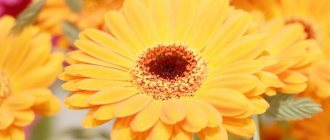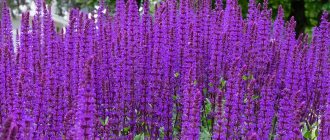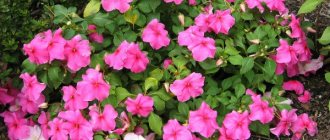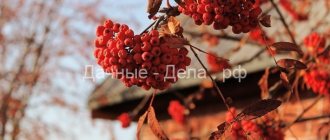Celosia is a plant from the Amaranth family. The buds are often compared to fire, which is where the name comes from. Celosia means flaming in Latin. In nature, these flowers are found on the American and African continents. There are divisions into classes, annual plants and perennials. However, in the central zone, any species is grown as annual crops, due to the harsh climatic conditions unsuitable for them.
Types and varieties of celosia
There are approximately 60 different species in total. Those used in culture are divided into 3 according to the shape of the flower:
- comb;
- paniculata;
- spikelet.
The most popular annual silver variety.
Comb
The height is small, only 45 cm. But this is not the lowest among other varieties.
The inflorescences formed are very similar in appearance to the comb of a rooster, both in shape and color. Flowering occurs in mid-summer and ends in mid-autumn.
| Variety | Description |
| Impress | The bush is of small height, maximum 25 cm. The leaves are dark, red. The inflorescences themselves are more faded, red. |
| Atropurpurea | The plant is no more than 20 cm. The shoots are pink. The flowers themselves are purple. |
| Imperialis | Stem, flowers, leaves are purple. |
| Coccinea | The leaf blades are green, the flowers are bright red. |
Cirrus (paniculate)
The shoots are straight, at their tops there are quite large inflorescences, their color has a wide range of shades. Starting from red to yellow. The leaves are a standard green color.
This type includes varieties such as:
| Variety | Description |
| Goldfeder | Low growth bush, golden buds. |
| Tomsoni Magnifica | 80 cm, stem height can reach 80 cm. The color of the buds is burgundy, the leaves are green. |
| Torchshain | Tall bush, bright red inflorescences. |
| New Look | Of medium height, 40 cm in height, the inflorescences have a sunny color. |
Koloskovaya (Hatton)
Less popular than the previous ones, but this does not mean that it is less beautiful. It is impossible to classify him as tall or short, since his height varies from 20 cm to 1 m 20 cm.
It directly depends on climatic conditions, soil, and the addition of fertilizers. The inflorescences are often yellow, but red, orange and white are also found.
Description
Celosia includes in its genus:
- perennial and annual species;
- semi-shrubs and full-fledged shrubs.
In the climate of the central zone of our country, it is grown as an annual due to its extremely low frost resistance.
The branches of the bush grow from thirty to ninety centimeters in height. They grow vertically, branching slightly at the top. The ribbed stems have a slightly rough bark of a light green color.
Previously, we talked about how to grow Kochia in the garden.
The foliage is entire, has an alternate leaf arrangement and can be oval, elongated oval and elongated lancet-shaped. The leaves grow on small petioles and have wavy or smooth edges.
There are some varieties in which the leaves do not have an even green color, but are mottled with stripes and stains of various colors.
Bloom
The flowering period of the plant begins in mid-summer and continues until late autumn. The inflorescences are located on the upper part of the shoots and have the shape of a panicle, feather, or spike. They contain many small yellow, orange, pink, scarlet, or other colored flowers.
Each of the flowers grows on a separate stalk, but they are so tightly packed in the inflorescence that many of the buds are practically indistinguishable. Typically, flowers in inflorescences are about twenty centimeters high. Each of the miniature flowers has three bright bracts, a clearly visible tube consisting of five stamens and a prominent ovary.
The flower is pollinated by bees and insects, after which small two-millimeter seeds are set and ripen. They are placed in an oblong, cylinder-shaped seed pod, up to four millimeters in diameter.
After ripening, the lid of the box flies off, and the seeds fall to the ground.
Of all the plant species, only three are cultivated by gardeners. Of these, in most cases, only one is grown, called silver celosia. This species has three varieties.
Celosia propagation
The most popular and effective propagation method is seeds. They are collected from dried inflorescences; the procedure does not require special skills. Dried flowers are simply shaken slightly over paper or some surface, and the seeds fall out on their own.
Before planting, they must be processed. This is done by placing the seeds in a solution of Epin and Zircon. Substances are added to water in a ratio of 1 drop of substance per glass of water. It is best to plant seeds in March. In this case, you need to maintain the required distance, depending on the type of plant. There is no need to sprinkle the seeds with soil; they just need to be lightly pressed into the soil, then sprinkled with water.
The following is a standard list of actions: the container with seedlings is covered with glass or film and placed in a place with good lighting. When the first shoots appear, the shelter is removed and the seedlings are transferred to a cooler place, with no less light.
Conditions for seed germination
In order for the seeds to germinate, the following conditions must be met:
- Constantly moist soil . If it dries out, don’t expect any germination. Therefore, check the soil daily. If it starts to dry out, spray it with boiled water at room temperature.
- Constant temperature at +23…+25 oC. This is easy to maintain if you cover the container with film. You will get a mini-greenhouse.
- Good diffused lighting. You can’t germinate seeds in direct sunlight, but you shouldn’t put the bowl in the shade either.
Open the greenhouse and ventilate it daily. Stagnant, humid air can lead to mold growth. For the same reason, it is necessary to remove accumulated condensation from the film every day. Such care will ensure the first shoots already on the 8th day after sowing the seeds.
Planting and caring for celosia
Planting in the ground occurs only during the period when the possibility of frost has passed. When choosing a growing location, you should give preference to a place that is well lit by the sun. It should also not be blown by the wind, as this has a bad effect on the delicate inflorescences of the plant.
The soil should not be too acidic, even if it is, it can be easily corrected with lime.
Unlike other plants, planting and replanting is not a difficult task, but you still need to be careful with the root system, especially in young species. If the seedlings were in peat pots or tablets, they need to be planted in open ground along with them. This will completely eliminate the possibility of damage to the roots of the plant, and will also act as a small fertilizer for the soil.
For short species, the gap must be maintained at least 15 cm. For tall species, about 30 cm.
In terms of care, cellosia is unpretentious. The only thing you need to closely monitor is that in the spring the plant does not die from the cold. This is especially true for young shoots.
It is recommended to water only when the soil is dry. The plant really does not like constantly wet soil, and this can also cause diseases such as gray rot.
Feeding is important in care, but it should be done no more than once a month.
The soil around the plant must be constantly loosened and weeds removed.
Even if the plant is grown at home, it also needs a large amount of light; in terms of its placement, a window sill in the sunny side of an apartment or house is perfect. Once every 2 weeks it is necessary to fertilize the plant containing mineral fertilizers.
However, you should avoid fertilizers containing nitrogen, as this will destroy the plant.
Soil for sowing seeds
To grow celosia from seeds, you need to prepare high-quality soil for seedlings. It should include:
- vermiculite – 1 part;
- humus – 1 part;
- washed river sand – 1 part;
- leaf or turf soil - 3 parts.
Mix all the ingredients and disinfect the resulting soil. To do this, it can be calcined in the oven or treated with a pink solution of potassium permanganate. After watering with potassium permanganate, the soil should be given time to dry.
Celosia after flowering
When celosia fades, you need to prepare it for wintering.
Collecting seeds
The process of obtaining seeds is probably the simplest in comparison with other plants. To do this, it is necessary to pick several already faded inflorescences, which are already beginning to die. Then they need to be placed in some vessel, vase, in a dark place for a day, where they will finally fade. Then remove from the container and gently shake over some surface or coating. The seeds will begin to fall out on their own. They need to be blown out, then put into a box for further storage. It is also possible to simplify this process; to do this, you need to hang the inflorescences so that they look down, and lay a sheet of newspaper under them. As soon as they wither, the seeds themselves will gradually begin to crumble, all that remains is to collect them.
Celosia in winter
Due to weather conditions that are not very suitable for this plant, all its species are grown as annuals. In the fall, the remaining specimens are usually disposed of and destroyed. But you can not only just throw them away, you can make beautiful dry bouquets out of them. To make this, only tall varieties are suitable.
Faded specimens are trimmed, all leaves are removed, and then brought indoors. There the inflorescences will finally fade, after which they can be placed in an empty vase, without water.
Origin
The flower belongs to the Amaranthaceae family, which includes over 60 different plant species, which mostly grow in the southern hemisphere of the planet. Most of them were bred artificially, by crossing existing species.
In this way, it was possible to obtain species that can tolerate cold well.
Diseases and pests of celosia
Naturally, the most susceptible to diseases and pests are those plants whose cultivation rules and care nuances were violated. An excess of moisture in the soil is extremely unacceptable, as this is the direct cause of rot. To protect the flower by at least 50%, the soil must be treated with insecticides before planting. During growth, it is necessary to carry out regular thorough examination, approximately 3 times a week.
| Problem | Description | Prevention | Corrective measures |
| Blackleg | It is a fungal disease that affects the stems and areas of the bush near the root. It is expressed in blackening and drying of the stem. In addition, it is very contagious; if one plant is sick, it is necessary to take immediate action, as it quickly spreads to healthy ones. | Moderate watering is recommended, soil drainage is required. It is also necessary to treat the seeds and soil with a weak solution of manganese, regularly loosen the soil, and clear it of weeds. | The affected area must be removed immediately as soon as signs of the disease are detected. The soil needs to be treated with a weak solution of potassium permanganate. This will contain the infection and prevent it from spreading to other, healthy shoots. |
| Aphid | A pest, very often accompanied by ant attacks. This is due to the sweet aroma of celosia, which attracts many insects. It appears in the form of larvae, which are located on the leaf, on its inner part. | It is necessary to remove all nearby anthills on the site, the soil in which the plants are located must be treated with a special solution. The same must be done with bushes. This solution can be bought at special garden stores. | If larvae are found, it is necessary to wash them off the plant with a soap solution, then treat them with insecticides. |
| Spider mite | The most dangerous pest. It attaches itself to the celosia nutrient medium, depriving it of the opportunity to fully grow and bloom. It is expressed as a white web, quite dense in the leaf axils, also near the base of the flower. If the inflorescence is bright, you may simply not notice it. In this case, small yellow spots appear on the leaf plate. | It is recommended not to neglect watering, regardless of the plant’s preferences. Carry it out in a timely manner, but do not over-moisten the soil. Air humidity also plays an important role; you can normalize the moisture percentage using a spray bottle, spraying the bushes with water. | It is necessary to wash off the affected areas of the plant with a soap solution; a sponge is perfect for this purpose. Then the plant needs to be sprayed with a special insecticide against ticks. |
If you neglect watering, or, on the contrary, overdo it, such unpleasant guests as snails, caterpillars and slugs may appear.
Diseases
Like all plants, the Celosia flower is susceptible to various kinds of diseases. Most often he suffers from “black leg”. It appears when watering is excessive and the roots begin to rot. You only need to water the flower on clear days; you don’t need to do this on cloudy days; rain will perform this function.
If the flower is already sick, you need to thoroughly loosen the soil, and then sprinkle wood ash on top so that it draws out moisture; watering should be slightly reduced.
Mr. summer resident recommends: using celosia
Cellosia is used for medicinal purposes by traditional healers and specialists. She is being treated for gastrointestinal disorders. Used for the treatment and prevention of oral and throat cavities.
Among the medicinal properties, the presence of an anti-inflammatory effect is also noted. To do this, the seeds are ground in a coffee grinder, then poured with vegetable oil. The result is celosium oil, which is used for skin redness and microcracks. Especially popular among women, it gives a velvety feel to the skin.
Why might seeds not grow?
- The expiration date indicated on the packaging has expired. Sometimes they try to revive them with the help of fertilizers, but this is a useless exercise, since even if some of them germinate, they will be weak.
- if the seeds were stored incorrectly, they will also not germinate
- you need to be more careful with the soil where you plan to plant the plants
- ineffective watering: flowers should not be over-dried or over-watered
- You should not bury the seeds when planting, they should remain on the surface
- there must be strict adherence to temperature conditions
- Before planting the seeds, they must be soaked; if this is not done, then most likely they will not germinate
Wintering
Celosia is not able to survive even mild frost, even with shelter. Therefore, there is no point in wasting time on warming the plant in autumn: it is better to collect flower seeds and grow new celosia in the flowerbed of your site in the spring.
The main difficulty in growing wildflowers is the process of seed germination. Having dealt with it and ensuring proper planting and care of celosia in the future, the gardener will receive a completely undemanding plant that pleases the eye with long and abundant flowering.

